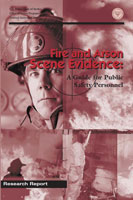|
View in browser: https://www.crime-scene-investigator.net/newsletter/0919.html
|
||
|
SEPTEMBER 2019 | ||
| ||
|
This Month's Featured Resource on the Crime Scene Investigator Network Website
|
||
 It is the intention of this Guide to acquaint a broad spectrum of public safety personnel with the fire investigation process, so they may understand their role in this important task and help identify, locate, and preserve evidence in its varied forms, to either assist a specialist investigator when one is needed or to adequately document and collect evidence when no assistance is needed or available. This Guide focuses on the documentation and collection of physical evidence at fire/arson scenes. <View the Publication> |
||
|
New CSI and Forensic Job Announcements
|
||
|
The most comprehensive listing of Crime Scene Investigation and Forensic To be notified of job openings as they are posted, follow us on Twitter: Job Posting Alerts |
||
|
Crime Scene Technician
Cocoa Police Department, Cocoa, Florida, USA Final Filing Date: September 26, 2019 The Crime Scene Technician examines major crime scenes to collect, identify, photograph, videotape, classify, sort, transmit, analyze, and dispose of department-held physical evidence related to criminal investigations. Responsible for photography, sketching, plaster cast construction, latent fingerprint detection, maintenance of evidence continuity, and testifying in courtroom prosecution. <View complete job listing> |
||
|
Crime Scene Technician I/II
Anne Arundel County Police Department, Millersville, Maryland, USA Final Filing Date: June 18, 2019 The Crime Scene Technician I is entry-level technical evidence collection work involving the examination of crime and accident scenes for the purpose of collecting and preserving evidence. Work includes learning to identify, collect, photograph, record and preserve evidence. The Crime Scene Technician II is the full performance level of skilled technical evidence collection work involving the examination of crime and accident scenes for the purpose of collecting and preserving evidence. <View complete job listing> |
||
|
Apprentice Crime Scene Technician
Richardson Police Department, Richardson, Texas, USA Final Filing Date: Open until filled Under supervision, undergo classroom training, field training, and other instruction designed to prepare the apprentice for assuming the duties and responsibilities of Crime Scene Technician. Perform other related work as required. <View complete job listing> |
||
 |
||
|
DNA Forensic Scientist 1
Idaho State Police, Meridian, Idaho, USA Final Filing Date: October 7, 2019 Provide scientific and technical expertise in genetics, DNA database sample analysis. Follow analytical methods and the quality and safety procedures. Document quality controls and work. Check that profiles entered are accurate. Provide expert testimony when applicable. <View complete job listing> |
||
|
Firearms ID Examiner III
Institute of Forensic Sciences, Houston, Texas, USA Final Filing Date: October 20, 2019 Evaluations and test firing of various types of firearms. Performs moderately complex and complex analysis of submitted firearms and firearms related evidence that may include hazardous biological and chemical substances. Performs serial number restorations (firearms). Performs gunshot residue / distance determination examinations. Issues reports accurately reflecting the results of examinations. Provides expert testimony in the discipline of Firearms Identification. <View complete job listing> |
||
|
Digital Forensic Analyst
Grand Junction Police Department, Grand Junction, Colorado, USA Final Filing Date: October 7, 2019 Perform forensic computer/digital evidence recovery and analysis on a wide variety of specialized visual and/or computer based related peripheral equipment and data storage devices. Perform a variety of advanced procedures to analyze digital multimedia evidence. Perform advanced analytical procedures to determine authenticity and integrity of evidence and comparative evaluations. <View complete job listing> |
||
|
Latent Print Examiner II
Oakland Police Department, Oakland, California, USA Final Filing Date: September 27, 2019 Analyze known and latent prints for comparison purposes. Operate all computers and computer-related equipment associated with automated fingerprint identification systems. Development of latent prints on objects using a variety of physical, chemical and/or optical methods. Collect latent prints or other impression evidence found at crime scenes or submitted to the laboratory. Present fair and impartial court testimony concerning findings, as established by laboratory analyses and interpret findings regarding all aspects of assigned duties. <View complete job listing> |
||
|
Property and Evidence Specialist
Costa Mesa Police Department, Costa Mesa, California, USA Final Filing Date: September 30, 2019 Receive, record, store, and maintain property and evidence for the Police Department including monies, firearms, and narcotics. Release or dispose of property and evidence upon authorization and in accordance with applicable policies, procedures, laws, codes, and regulations. Contact the Department of Justice regarding the release of weapons to owners. Prepare authorized items for sale in auctions. Retrieve and return property items to various businesses. Deliver evidence to court. <View complete job listing> |
||
|
Search for more job listings in Crime Scene Investigations and Forensics To be notified of job openings as they are posted, follow us on Twitter: Job Posting Alerts |
||
|
Other Resources on the Crime Scene Investigator Network Website
|
||
|
Not Subscribed to this Newsletter?
|
||
|
If you are not subscribed to this newsletter, you may subscribe with this link: SUBSCRIBE via email |
||
|
To Unsubscribe
|
||
|
To unsubscribe from future e-mail newsletters, please click here: UNSUBSCRIBE Copyright ©2019 Crime Scene Resources, Inc. Crime Scene Investigator Network |


